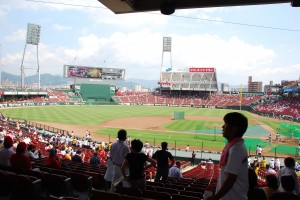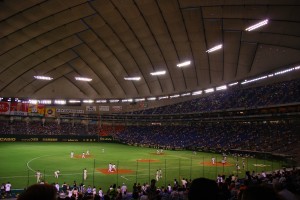
- Image via Wikipedia
Baseball fans across America are familiar with the Yomiuri Giants because they are the Yankees of Japan and the Chiba Lotte Marines because Bobby Valentine managed them for seven seasons. But what do we really know about the teams and players of Japanese baseball? Since the scope of my experience spans about five games a year, I decided to turn to an expert to explain the finer points of NPB.
Enter Brandon Siefken, an author and Japanese baseball analyst who runs the website japanbaseballnews.com. Brandon’s introduction into the world of Japanese baseball began as a college exchange student in Nagoya, where he attended Chunichi Dragons games with his host family. After graduating from the University of Arizona, Siefken returned to Japan in 1991 and has been compiling statistics, providing analysis, and plotting pitches ever since.

MLB has imported the likes of Ichiro Suzuki, Hideki Matsui, and Daisuke Matsuzaka from Japan, and it seems that trend will continue. I’ve often heard that Japanese players want to sign with MLB teams because they want to play against the best. Is the level of play really that different between the two leagues? According to Siefken, it’s true that MLB has the best players. “MLB is the zenith of world baseball,” says Siefken via e-mail. “That being said, the level of Japanese baseball has risen exponentially in the last decade or so. The Japanese play the fundamentals of baseball better than anyone in the world. The work ethic, fielding, stealing bases, hitting for contact and the concept of small-ball manufacturing runs is played exceptionally well in Japan.”
Even with its emphasis on the fundamentals, NPB is not as talented as MLB. “What they lack is the power game,” Siefken continues, “and I attribute that mostly to the lack of size. The average players in Japan are smaller than those in the U.S. and less muscular. If a pitcher makes a mistake in Japan, he might get tagged for a single, where the same mistake in the U.S. would cost him a home run. MLB hitters not only have power, but they are the best in the world at adjusting to a pitcher. There is no doubt MLB hitters are far more dangerous than Japanese hitters.”

During the baseball season Siefken publishes a weekly newsletter. Subscribers pay $14.95 a year to receive scouting reports of both professionals and amateurs and to have access to a stats database on every pro player in Japan. Some of his subscribers include MLB scouts, leading me to ask him if his website is contributing to the exodus of Japanese players into North America. “ . . . I believe it is broadening the reader’s view of Japanese baseball and the players here, who have been relatively anonymous for years,” Siefken says of his website. “ . . . I do not think there are other sites that break down the numbers and stats of Japanese baseball like mine does. That can only be a good thing for MLB and for NPB.”
In contrast to Bobby Valentine, Siefken doesn’t think the increased number of Japanese players in MLB is hurting Japanese baseball or depleting the league of its talent. He says the fans will be there no matter who – or how many – leave. “Japanese fans follow teams here more than players. They will still support their team when it is time to watch baseball.”
In the meantime, there are twelve teams in NPB that began the season in late March. Who are the teams to watch? Despite a losing record this season, the Hiroshima Carp is a team who Siefken believes should make the playoffs soon. “They have strung together two great drafts in a row, picking up players like Takeshi Komatsu, Ren Nakata, and Takeru Imamura,” says Siefken. Another team on the rise is the Chiba Lotte Marines under new manager Norifumi Nishimura. Siefken likes Chiba starters Yuki Karakawa and Yoshihisa Naruse, and their top draft pick from last year, outfielder Takashi Ogino, is having a great season.
It remains to be seen if these names will become as familiar as Ichiro, Godzilla, or Dice-K. One Japanese baseball superstar, however, might make the jump to MLB as early as next season. He’s Yu Darvish, the gifted right-hander for the Nippon Ham Fighters. “He has an amazing natural talent that is rare,” says Siefken. “There is one AL East MLB team with a scout following Darvish’s every start.” Last year’s Pacific League MVP, the 23-year-old phenom is, as of this writing, 2-1 with a 1.74 ERA and 47 strikeouts in 31 innings pitched this season.
Siefken, who developed “The Kuroda Index” to project how Japanese pitchers will fare in MLB, says that Darvish “will be a very good pitcher in the U.S. He is too talented and physically gifted not to succeed.”
Special thanks to Brandon Siefken for his time and expertise in this month’s installment. Visit japanbaseballnews.com for NPB stats done in amazing detail.
By special request – or possibly demand! – I will write my tell-all story about the glorious food available at Japanese ballparks. Look for that in May.

![Reblog this post [with Zemanta]](http://img.zemanta.com/reblog_e.png?x-id=d50091d5-7f30-45db-a31e-2ede924b58ee)

Brandon is clearly a visionary based on the potential he sees in the Hiroshima Carp. Great interview, Susan. Hope to see more great stuff from you on the site.
If anyone wants more on this, she posted the whole interview here: http://shrinecastle.blogspot.com/2010/04/interview-with-japanbaseballnewscoms.html